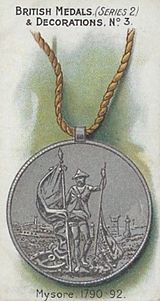Mysore Medal facts for kids
Quick facts for kids Mysore Medal |
|
|---|---|

The front of the medal shown on a cigarette card
|
|
| Type | Campaign medal |
| Eligibility | Native HEIC forces |
| Awarded for | Campaign service |
| Campaign(s) | Third Anglo-Mysore War |
| Clasps | None |
| Statistics | |
| Established | 1793 |
The cord used to wear the medal |
|
The Mysore Medal was a special award given to soldiers. It was a campaign medal, meaning it was given for taking part in a military campaign or war. The medal was awarded by the Governor-General of India to Indian soldiers. These soldiers were part of the armies of the Honourable East India Company (HEIC). They received the medal for fighting in the Third Anglo-Mysore War. This war took place between 1790 and 1792.
What Was the Mysore Medal?
The Mysore Medal was created to honor the bravery of Indian soldiers. These soldiers fought for the British East India Company. The medal was a way to say "thank you" for their service. It showed that they had helped the Company win an important war.
Who Received the Medal?
The medal was approved in April 1793. This was done by Lord Cornwallis. He was the Governor-General of India at the time. He had also led the Company's forces in the war.
Only Indian soldiers of the East India Company received this medal. Different ranks got different types:
- Gold medals went to senior Indian officers, like Subedars.
- Silver medals were given to junior officers, such as Jemadars and Serangs.
- Smaller silver medals were for non-commissioned officers (NCOs) and regular soldiers. This included Havildars, Naiks, Tindals, and Lascars.
European soldiers, even those working for the East India Company or the British Army, did not get this medal. It was specifically for the Indian forces. About 7,000 medals were given out in total.
Besides the medal, soldiers who fought in the war received extra pay. This was called a "batta allowance." It was like a bonus payment for six months. Also, the Company's regiments that fought in the war received a special honor. This was called the battle honour Mysore (1789–91). It meant their regiment was recognized for its part in the Mysore campaign.
How the Medal Looked
The Government of India hired a goldsmith in Calcutta to make the medals. They made the molds (dies) and then pressed the medals. Medals were made in both gold and silver.
The gold medals were about 1.7 inches (43 mm) across. The silver ones came in two sizes: 1.7 inches (43 mm) and 1.5 inches (38 mm). All the medals had the same design.
Front and Back of the Medal
- The front (obverse) of the medal showed a full picture of an Indian soldier. He was holding a British flag (the Union Jack) in his right hand. In his left hand, he held the flag of Mysore, but it was upside down. This showed that Mysore had been defeated. In the background, you could see the fortress of Seringapatam. There were no words on the front.
- The back (reverse) of the medal had a laurel wreath design. Inside the wreath, it said in English: FOR SERVICES IN MYSORE AD 1791-1792. Around the edge, there was a message in Persian. This message translated to: A token of the bravery of the troops of the English Government in the war in Mysore, in the Hijri years 1205-1206.
The medals were given out without any names engraved on them. Each medal had a ring at the top. This allowed soldiers to wear it around their neck. They used a cord, usually yellow or sand-colored, to hang the medal.

